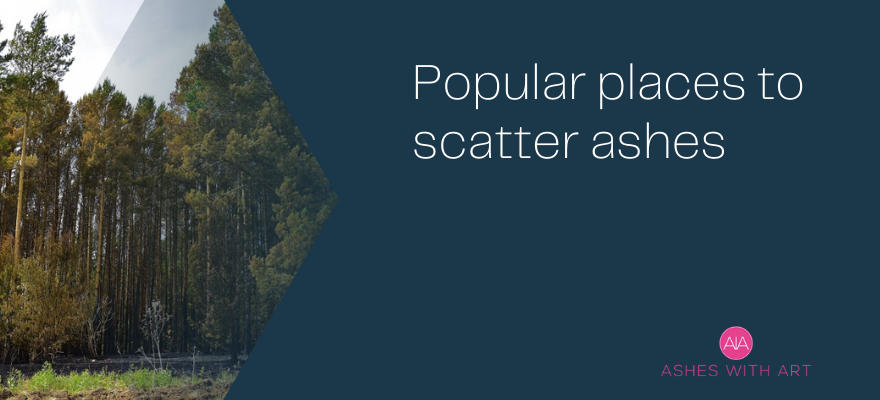How and where to scatter ashes
Scattering a loved one’s ashes is often the final way to say goodbye. It can be a very confusing and emotionally distressing time, so finding support from those around you is essential.
There are some practical considerations to scattering ashes, and also some emotional factors to consider. The location, how you scatter and ashes, and what to do after you have scattered the ashes are all things to consider.
In this guide, we will attempt to answer some of the most common questions individuals have about scattering ashes.
Who gets to decide to scatter the ashes?
If the individual has left a will stating where their ashes should be scattered, you are required by law to carry this out. If the person has left no such instructions, it is down to their loved ones to determine how they should handle the ashes.
Choosing to scatter ashes
The first factor to consider is whether you want to scatter the ashes, bury them, or keep them in your home. Scattering the ashes can provide some closure and allow individuals to move on. However, it might take time to reach this point.
You don’t have to make a decision immediately after the cremation. Some people choose to wait to scatter the ashes on the first anniversary of their loved one’s death to delay the need to make a decision. After a year of grieving, you might feel more prepared to make a decision about what to do with the ashes.
You might also decide that it is best to part with the ashes sooner. Holding on to the ashes can prologue the grieving process and make it harder to accept your loss. It could be that scattering the ashes provide the closure you need to move on, while still giving you a place you can visit to remember them.
Whatever you choose to do, it’s important to remember that there is no right or wrong way to take this next step after the death of a loved one. You simply have to follow your heart and hope that the path you choose helps you to find closure.

Is it bad luck to keep ashes in the house?
No, it isn’t bad luck to keep a person’s ashes in your home. In fact, some people find that keeping the ashes in their homes brings a lot of comfort. You might feel an emotional connection to the ashes which helps you process and handle your grief.
If you are superstitious or have superstitious family members, you might object to having ashes in your home. But if you do feel an emotional connection to the ashes, this might provide more comfort than expected. Those who are superstitious are more likely to want to keep the ashes close to them.
There shouldn’t be any religious objections to keeping the ashes in your home. If your religion permits cremation, then storing the ashes in your home shouldn’t be a problem. If your religion does not permit cremation, but cremation is required for whatever reason, you should consult with a faith leader to determine what to do next.
Do I have to scatter all of the ashes?
No, you don’t have to scatter all of the ashes at once. You might scatter the ashes in multiple places, or even keep some of the ashes at home. It’s also increasingly common to have the ashes added to keepsakes and memorial jewellery. You could also add ashes to a piece of glass wall art.
If there is a family dispute about what to do with the ashes, setting some aside to set in ashes jewellery and other keepsakes might help to resolve issues.
In general, we do not advise adding ashes to any kind of resin. This is not a suitable material for a memorial as the plastic resin will break down over time. Instead, focus on choosing long-lasting materials such as glass, or precious metals like gold and silver.
What if there is a dispute about scattering the ashes?
It’s not uncommon for families to dispute what should happen to ashes. One family might want to scatter them in a treasured place, another might want to bury them and another might want to keep them.
In this instance, the best thing to do would be to agree to do nothing until you can reach a satisfactory compromise. Immediately after a funeral is not the ideal time to make any decisions, so give it time and revisit the conversation once everyone has had time to grieve.
You might find that the easiest way to settle the problem is to split the ashes and allow individual family members to organise their own memorials.
Is it bad luck to split up ashes?
No, it isn’t considered bad luck to split up ashes. Some people think there might be religious objections to this practice, but as a general rule, if cremation is allowed then there will be no restrictions on what you can do with the ashes.
If an individual was cremated against their religious wishes, it’s important to consult with a faith leader to determine what to do next. There are some instances when cremation is required, or
Some family members might feel uncomfortable splitting the ashes and would prefer the ashes to remain complete. This is a discussion that needs to take place between the individuals involved to determine the best way to move forward.
What is the proper way to scatter ashes?
First things first, you will need to find a location to scatter the ashes. It’s common to find a place of natural beauty away from crowds so that you can have some privacy. There are usually fewer people present when you scatter the ashes than would be at the funeral.
If you are scattering the ashes on private land, you should always ask for the landowner’s permission before going ahead. While many people will not have a problem with this, they might request that you don’t disturb specific areas.
If you want to scatter ashes in a public park, always check with the local authority to find out if there are any restrictions. Most will have no restrictions, provided you do not cause damage to the park or disturb other park users.
When thinking about where to scatter your loved one’s ashes, think about places they loved to visit. This could include a park where the individual liked to spend their time, on their favourite football ground, or even out on a lake where they liked to fish.
Scattering the ashes on the water might be more complex as you would need a boat. An alternative would be to scatter the ashes from the shore.
Keep the number of people present to a minimum to avoid disturbing others around you. Scattering ashes is often a more informal occasion than the funeral, but you might want to say a poem or a prayer to say goodbye. Others might choose to simply have a moment of silent reflection.

Can I scatter the ashes at the crematorium?
Many crematoriums offer a space where you can scatter or bury the ashes. You might be able to dedicate a tree, shrub or rose bush to your loved one. Another alternative would be to place a mounted wall or kerb plaque to memorialise your loved one.
Crematorium memorials are often reserved for a specific amount of time before being made available to another grieving family. After this time, you could move your plaque to a memorial bench or similar to give you a place where friends and family can visit. Many people like to have the equivalent of a graveside to visit and place flowers on special occasions.
What happens to ashes after they are scattered?
It’s a good idea to scatter the ashes over a wide area of ground to ensure they are not concentrated in a single area. Once exposed to the elements, the ashes will react with their surroundings and all but disappear within a few days. There might be small traceable amounts visible after a few days, but these will soon break down.
Is it safe to touch cremated ashes?
Yes, it is safe to touch the ashes but most people prefer to release them from a cremation tube. This is a specially designed tube that allows you to scatter the ashes without touching them. Placing them in a tube also helps to direct the ashes and avoids causing a cloud when releasing them from a box.
Ashes stick to your hand very easily, so it’s a good idea to wear gloves if you aren’t scattering the ashes in water. If you are scattering them in water, it will be easy enough to wash away the ashes when you have finished.
Ashes are not toxic to humans, but they can be harmful to plant life. This is due to the very low PH level which can affect soil and anything growing in it. This is one of the reasons that it is important to check with landowners before scattering or burying ashes on their land.
And if you do scatter ashes, try to spread them over a larger area to avoid concentrating the ashes in one place.
Can I scatter ashes anywhere?
No, you should always seek permission before you scatter ashes. Busy places such as football stadiums and golf courses might not appreciate individuals scattering ashes on their property. While not hazardous to health, it might make others uncomfortable.
When choosing where to scatter ashes, you should think about what the individual loved to do in their life. This will allow you to select a place where you can visit and be reminded of your loved one.

Popular places to scatter ashes
If your loved one hasn’t left instructions for where they would like to be scattered, you’ll have to think about places that were meaningful to them. It’s possible to scatter ashes in a variety of places throughout the UK.
Here are some of the most common places to scatter ashes:
-
In a churchyard, burial ground or cemetery
-
Out at sea
-
On a lake
-
In a river
-
In a national park
-
In a back garden
-
On a sports ground
-
On private land
What are some alternatives to scattering ashes?
If you don’t feel ready to part with your loved one’s ashes, or you don’t want to scatter them, there are alternative ways to memorialise them. We create beautiful memorial jewellery that will enable you to keep a small amount of your loved one’s ashes with you at all times.
This can often help those who are struggling to let go of the ashes. A small amount of the ashes are placed in a piece of jewellery and then the rest may be buried or scattered. We can also place ashes in glass keepsake pebbles, Christmas ornaments and glass wall art.
Another alternative to scattering ashes is to plant the ashes with a tree. Tree urns allow you to say goodbye to a loved one and then watch a tree grow where you placed their ashes. This is an incredibly touching way to memorialise a loved one and create a special place you can return to.
For a creative way to memorialise a loved one, you could consider adding the ashes to a coral reef urn. This involves placing the ashes in an artificial coral reef which is then placed on the ocean floor. The ashes will then become part of the underwater ecosystem and create a home for aquatic life.
If you’re thinking about cremation and what to do with the ashes, a visit to our Worthing studio and workshop might help you to make this important decision.
Our team can help you to decide on the best memorial jewellery for your loved one and can advise on how to prepare the ashes to be added to jewellery. Only a teaspoon of ashes is needed to create a stunning memorial that you can keep with you at all times or display in your home.






